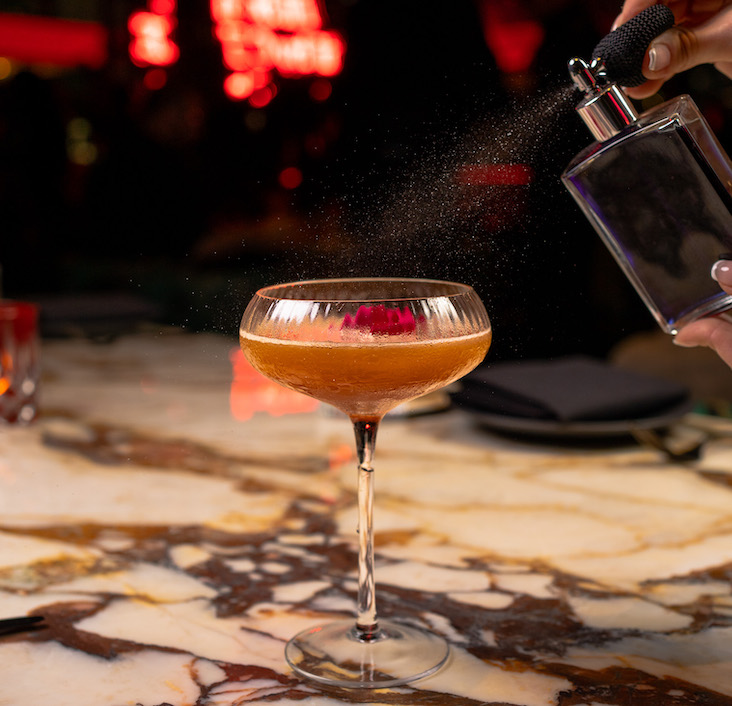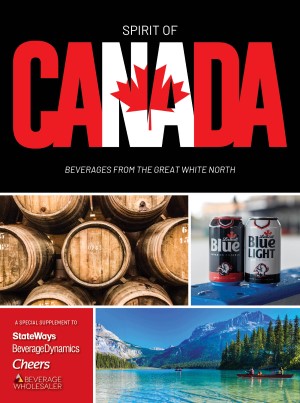American whiskey has long been a complex category with lasting allure. It has also grown and evolved to have pockets of fast-rising cachet. “It’s at the beginning of the curve,” says Jean-Pierre Etcheberrigaray, Atlanta-based vice president of operations, food and beverage for the Americas for the InterContinental Hotels Group, which has 24 locations in the United States. He attributes the rising interest in American whiskeys to several drivers, including a desire among younger drinkers to consume local and regional products, increased use of Bourbon and rye by high-profile mixologists and the perception that the product has improved. Interest is also being generated by the presence of an ever-widening array of small-batch and artisanal spirits offered by the category.
American-made whiskeys have also captured attention due to their reasonable pricing, relative to Scotch and other imported whiskeys. Ethan Kelley, beverage director at New York’s Brandy Library, explains that budget-conscious drinkers are finding that for a comparable price, “You can drink the best of the best Bourbons, compared to going midrange in other categories.” Brandy Library serves about 50 Bourbons, with most priced at $12 to $14 for a two-ounce serving.
On-premise American Whiskey sales rose 4.3 percent in 2009 according to data from Cheers’ parent company The Beverage Information Group. That’s quite a respectable increase considering last year’s challenging economic climate. The three top straight whiskey brands—Jack Daniel’s, Jim Beam and Evan Williams—kept the same ranking as in 2008 according to BIG.
There’s no overstating the continuing power of Jack and cola and Jim Beam and cola as two of the category’s most important call drinks. However, some operators are also observing a slow shifting of the demographic tides. The rising popularity of both Bourbon and rye has created a “halo effect” for all American whiskies. Some bartenders report that many younger urban drinkers are jumping over vodka and going straight to whiskey and sometimes drinking it straight up. Others note an increase in female whiskey drinkers.
InterContinental’s Etcheberrigaray also notes that younger drinkers, in particular, are embracing the “go local” aesthetic and emphasizes that it can result in good, relatively inexpensive whiskey products being available at many more bars.
Home Town Appeal and Rock Star Spirits
American whiskies also have regional appeal in an era when operators are focused on locally sourced products more than ever. “[Many patrons] want something with more oomph and something home-grown,” says Zafar Naqvi, general manager of HearSay Gastro Lounge in Houston, Texas. “People watch the Food Network and see them talking about buying local.” And that attention extends to beverages, he says.
“If you can grow something locally with the local weather with the local terroir, it makes a lot of sense,” Etchiberrigaray adds. It can even result in a smaller carbon footprint, he notes, which is attractive to eco-sensitive imbibers. He also flags the “oomph” factor as a draw for many whiskies. “You want something with a little more kick, punch, machismo. Americas like a little ‘leather’ in their drink.”
Interest in rye and Bourbon particularly has been growing by leaps and bounds, according to many operators. While still relatively small overall, rye is showing the briskest growth in the American Whiskey category, surging more than 50 percent in 2009 according to the Cheers On-Premise Barometer Handbook. Much of that success has been driven by bartenders, who are championing the spirit’s role in classic cocktails.
The 105-room Sanctuary Resort on Camelback Mountain, in Paradise Valley, Arizona, features a “Rye Revival” section on its cocktail menu, which features a mix of classic and new cocktails, priced from $10 to $13. American Whiskey accounts for about 30 percent of spirits sales, which is unusual for a bar located in such a hot climate. Among the 75 American whiskies carried, priced from $8 to $35, mixologist Jason Asher has culled a dozen ryes.
“I get specific requests for Old Fashioneds, Manhattans and other classic cocktails to be made with rye,” he says. “And we make a point of picking the rye that goes into each cocktail, so it won’t overshadow the cocktail.” For example, he uses the lighter Old Overholt in the classic Sazerac ($11), but chooses the more robust Wild Turkey 101 Rye for his version of the Manhattan ($11), along with Noilly Prat sweet vermouth and Angostura bitters.
Customer favorites include the Ward 8 ($11), a rye whiskey sour made with Rittenhouse Rye 100, house-made grenadine, orange juice, lemon juice, orange flower water and vanilla. Another is the Honeysuckle ($11), a classic spin on the Bee’s Knees, made with Michter’s Rye, local wildflower honey and fresh lemon juice.
Although part of the appeal is that rye was the main spirit used in classic cocktails, Asher notes, the other part is the price point. Rye can be less expensive than imported whiskies and even premium Tennessee whiskey like Jim Beam. It’s more affordable, “so we can use it and maximize profits.”
Rittenhouse Rye is among the most heavily used spirits in the bar, Asher says. “They even bottle some early for me, because I go through so much of it.” He goes through two to three 12-bottle cases per month of the 100-proof version.
Bourbon’s Appeal
Bourbon, which accounts for nearly half of straight whiskey consumed on-premise, according to BIG, also has gained fans and seems poised to accelerate further. Just ask Brandy Library’s Kelley, who says that Bourbon accounts for nearly one-third of all of the bar’s whiskey sales, outpaced only by single-malt Scotch.
In fact, he’s so confident about Bourbon’s appeal that the Brandy Library organized a full-on Bourbon Week for the first time at the bar around the Fourth of July, with Bourbon flights, cheese and dessert pairings complete with a Bourbon cocktail contest. For the challenge customers made the drinks and the staff choose the finalists’ cocktails, which were served at a Sunday Bourbon Cocktail Brunch. The winning cocktail will be on the Brandy Library menu for one year. Kelley estimates that during the weeklong event, Bourbon sales increased about 20 percent.
When it comes to Bourbon, trends are pretty clear. Many operators are seeing it consumed neat or on the rocks. At The Sanctuary Resort, Asher provides Bourbon-drinking guests with sides of water and ice, encouraging them to experiment and ask questions.
Bourbon cocktails also remain popular. Standards like Old Fashioneds, Manhattans and Mint Juleps still go a long way toward elevating Bourbon awareness. At Hearsay, where Bourbon neat is the go-to, an award-winning riff on the classic Old-Fashioned has brought in press coverage and customers. The Old Fashioned New School ($10) is a top seller, made with Maker’s Mark Bourbon, Luxardo cherries and an orange garnish. Instead of mixing in the bitters, they are sprayed over the top of the drink for bolder aromatics and a touch of showmanship.
Small Batch Biz
Jim Beam remains the category leader by a wide margin. It is the best-selling Bourbon nationwide after Jack Daniel’s and the second best-selling American Whiskey brand nationwide. But small-batch and special bottlings are also garnering interest among bartenders and consumers, and the category grew by 7.8 percent in 2009, according to BIG. This applies to rye and Tennessee whiskey as well, but enthusiasm has been most pronounced among Bourbon.
At Brandy Library, small-batch Bourbons are particularly robust sellers; Kelley counts Basil Hayden, Knob Creek, Blanton (all priced at $14) and Van Winkle (priced from $12 for 10-year-old Old Rip Van Winkle to $66 for 23-year-old Pappy Van Winkle) among the most asked-for brands. Similarly, top brands at The Sanctuary include Elijah Craig 18-Year-Old and Pappy Van Winkle.
“It’s hard to discount the craft distillery movement,” Kelley says. Beyond simple affection for some boutique brands, “these craft distilleries are opening consumers’ eyes and getting a lot of press and getting attention for American whiskey.” In other words, all American whiskeys are rising on the tide created by the little guys with a good story.
In June, William Grant & Sons announced a partnership with Tuthilltown Spirits, a cult whiskey brand based in New York’s Hudson Valley. Tuthilltown has been quick to clarify that it will continue independent production of their Baby Bourbon, Hudson Manhattan Rye and other products, while Grant will be involved in broadening distribution. However, the move certainly raises questions about whether other larger and smaller producers will join forces in a similar fashion.
“In everyone’s quest to go boutique, they look over the big guys who were smart enough to get in when they did,” Kelley says, “and there are some fantastic high-production bottles out here that are priced to use in cocktails.” He ticks off names such as Wild Turkey Rye, which he says is an amazing buy, especially in a cocktail, Rittenhouse, Evan Williams Black Label, Elijah Craig 12-Year-Old rye and Buffalo Trace.
Game-Changer: The Iconic Drink
The missing element many say is preventing a full-on American whiskey revival is the lack of a signature cocktail. Just as the Margarita catapults tequila sales and the Caipirinha drives cachaça, imbibers have yet to embrace one specific, iconic American whiskey-driven drink. And that could be a game-changer.
“Young people don’t drink the Old-Fashioned,” notes Etcheberrigaray. “If they did, it would boom. But someone will come up with the right drink.”
The closest rival now is the Jack Daniel’s & Coke, which consistently ranks among the top-10 most popular drinks at on-premise accounts, according to BIG’s 2009 Cheers OnTrack Bar Manager Study. And this in part explains why Jack Daniel’s Black is the leading brand of American whiskey, garnering nearly 40 percent of all 2009 American Whiskey sales, according to Cheers’ data. However, the Jack and Coke still lags behind other well-known standards, including the Margarita, Martini and the Rum and Coke.
Amid the rise of Bourbon and rye, some bar managers also observe that Canadian Whiskey has ceded some ground. However, mixed drinks such as 7&7 continue to feed demand for Canadian whiskey. No wonder Seagram’s 7 Crown clocks in as the third-leading brand of American Whiskey, garnering 10 percent of on-premise sales, according to BIG.
So what does the future hold for American whiskey? Etcheberrigaray consults his crystal ball: “Rye is going to boom,” he predicts. “Bourbon will become an icon of the American drink; already it is being exported and is becoming chic around the world. It will take over the whiskey category.” Look out, Scotch, American whiskey is coming up fast.




